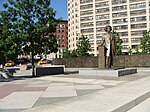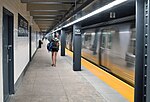Frederick Douglass Circle

Frederick Douglass Circle is a traffic circle located at the northwest corner of Central Park at the intersection of Eighth Avenue (Frederick Douglass Boulevard and Central Park West) and 110th Street (Cathedral Parkway and Central Park North) in the New York City borough of Manhattan. The traffic circle is named for the American abolitionist, women's suffragist, editor, orator, author, statesman, and reformer Frederick Douglass. Frederick Douglass Circle connects the New York City neighborhoods of Harlem with the Upper West Side. Harlem, a major African-American residential, cultural, and business center, is to the north and east of the intersection. Cathedral Parkway climbs westward from here into Morningside Heights, which includes Columbia University, the Manhattan School of Music, and the Cathedral of St. John the Divine.
Excerpt from the Wikipedia article Frederick Douglass Circle (License: CC BY-SA 3.0, Authors, Images).Frederick Douglass Circle
Frederick Douglass Circle, New York Manhattan
Geographical coordinates (GPS) Address Nearby Places Show on map
Geographical coordinates (GPS)
| Latitude | Longitude |
|---|---|
| N 40.800583 ° | E -73.958167 ° |
Address
Cathedral Parkway–110th Street
Frederick Douglass Circle
10026 New York, Manhattan
New York, United States
Open on Google Maps










